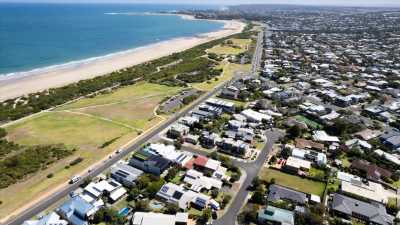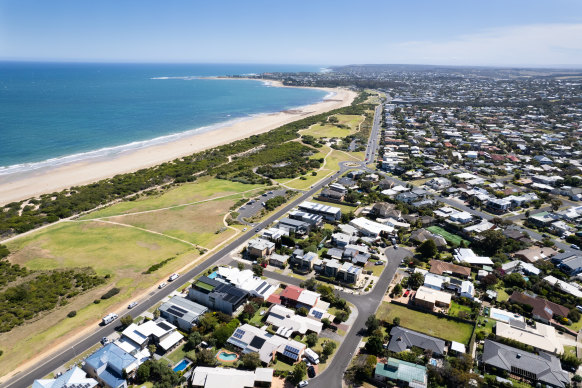The once-booming Victorian tree change towns where rent is slowing

Save articles for later
Add articles to your saved list and come back to them any time.
Key points
- Rent growth has started to slow across regional Victoria.
- Some areas are still recording strong growth, driven by tourism and short-term rentals.
- Experts say there will be some relief for regional renters.
Property listings
The once-breakneck pace of regional rent growth has slowed across much of Victoria, which indicates the pandemic tree and sea change trend is diminishing.
The median asking rent outside the greater Melbourne area was $450 per week over the June quarter, up just $4 per week over three months but a steeper increase of $30 per week over the previous 12 months, Domain data shows.
Asking rents for houses fell the most in the Ararat council area to $340 per week, down 5.6 per cent. That was followed by Moyne, in south-west Victoria, where rents fell 2.3 per cent ($430). Rents were stagnant in the Surf Coast ($620 a week), Bass Coast ($450) and Hepburn ($450) shires and in Wangaratta ($420).
In six of 35 council areas, rents were either stagnant or falling, but during the lockdown-era boom, rents in each of the six regions skyrocketed between 26 per cent and 40 per cent.
Rents in other areas continued to soar. House rents increased the most in the Strathbogie council area, where they rose 21.6 per cent to $450 a week. That spike was followed by Swan Hill at 15.6 per cent ($370) and Moira, in the north of the state, at 13.2 per cent ($430).
Domain head of research and economics Dr Nicola Powell said the slowing rates of growth would ease life for regional tenants.
Rents are holding steady on the Surf Coast.Credit: Jason South
“The regions overall have hit a new record high over the June quarter, but I would say we’re seeing a slower pace of growth,” she said.
“Particularly for houses. But overall the general theme is the pressure is being released in regional markets.”
Powell said Melbourne residents were no longer fleeing the inner city in huge numbers since the end of lockdowns, and the return of international migration was shifting demand for rentals back to the metropolitan area.
“It’s a reflection of less of a tree change effect,” she said. “It was very evident during the pandemic for valid reasons and those demographic shifts in Victoria were much more prominent because of the lockdowns and the outward flow of [people to other states].”
Despite this, some areas would still struggle with affordability.
“Some of these regional markets have seen such a vast change in asking rents. Local affordability has been greatly stretched,” Powell said.
Bendigo and Adelaide Bank chief economist David Robertson said there were large increases in rent in regional Victoria earlier in the pandemic, but agreed pressure and prices had eased as demand from sea- and tree-changers reduced and affordability deteriorated.
“There are still really tight rental conditions everywhere, but the latest data does suggest capital cities have seen a further surge in rental costs and levels, while some of the regional locations have seen a deceleration,” he said.
Robertson said there had been a slowdown in tree and sea change activity. However, in aggregate, more people were still moving to the regions than the reverse, which put upward pressure on demand.
Great Ocean Properties listing agent and property manager Michelle McDonald said the Surf Coast’s rental market had cooled, and there were more vacant properties than there were 12 months ago.
“Whether that’s because there are new properties going onto the market that have never been rented before, or there may be owners of properties trying to respond to the news that people can’t access rentals because there aren’t enough,” she said.
McDonald had also seen less demand.
“And then the prospective renters, there aren’t as many looking as there have been over those COVID years,” she said. “Even with the primary schools, there’s less young kids at the schools than what there had been over the last couple of years.
“That could be an indicator that families have moved out of the area.”
While affordability was still constrained, McDonald said tenants had more bargaining power.
That was not the case for all regions. McGrath Mansfield principal Kate McDougall said high-yield holiday rentals offered were attractive to landlords in the nearby Strathbogie council area.
“We’re in a very high tourist area, we’re not far behind Bright,” she said. “We’ve got two ski resorts on our doorstep, and all the mountains feed into these river systems which feed into these two big lakes.
“We have all year round tourism and when that happens you have Airbnb. People who would be doing long-term rentals go into the lucrative Airbnb market.”
McDougall said the demand was affecting the region’s social fabric.
“You want all that growth that comes with Airbnb, but there’s a short supply of affordable rental for staff and everyone living around our town,” she said.
“It feeds the town, so it can flourish in the tourist sector, but it pushes people out. There’s a lot of people who are looking to move out of town because it’s cheaper.”
McDougall said she’d seen the trend start to ease, however, and noted some clients had converted short-term rentals back into long-term.
Most Viewed in Property
Source: Read Full Article
